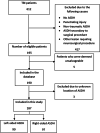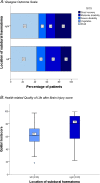A multicentre retrospective cohort study on health-related quality of life after traumatic acute subdural haematoma: does cranial laterality affect long-term recovery?
- PMID: 35915402
- PMCID: PMC9341107
- DOI: 10.1186/s12883-022-02790-3
A multicentre retrospective cohort study on health-related quality of life after traumatic acute subdural haematoma: does cranial laterality affect long-term recovery?
Abstract
Background: Traumatic acute subdural haematoma is a debilitating condition. Laterality intuitively influences management and outcome. However, in contrast to stroke, this research area is rarely studied. The aim is to investigate whether the hemisphere location of the ASDH influences patient outcome.
Methods: For this multicentre observational retrospective cohort study, patients were considered eligible when they were treated by a neurosurgeon for traumatic brain injury between 2008 and 2012, were > 16 years of age, had sustained brain injury with direct presentation to the emergency room and showed a hyperdense, crescent shaped lesion on the computed tomography scan. Patients were followed for a duration of 3-9 months post-trauma for functional outcome and 2-6 years for health-related quality of life. Main outcomes and measures included mortality, Glasgow Outcome Scale and the Quality of Life after Brain Injury score. The hypothesis was formulated after data collection.
Results: Of the 187 patients included, 90 had a left-sided ASDH and 97 had a right-sided haematoma. Both groups were comparable at baseline and with respect to the executed treatment. Furthermore, both groups showed no significant difference in mortality and Glasgow Outcome Scale score. Health-related quality of life, assessed 59 months (IQR 43-66) post-injury, was higher for patients with a right-sided haematoma (Quality of Life after Brain Injury score: 80 vs 61, P = 0.07).
Conclusions: This study suggests patients with a right-sided acute subdural haematoma have a better long-term health-related quality of life compared to patients with a left-sided acute subdural haematoma.
Keywords: ASDH; Acute subdural haematoma; Acute subdural hematoma; Health-related quality of life; Laterality; Qolibri; Quality of life.
© 2022. The Author(s).
Conflict of interest statement
The authors declare that they have no competing interests.
Figures


Similar articles
-
Comparative effectiveness of surgery in traumatic acute subdural and intracerebral haematoma: study protocol for a prospective observational study within CENTER-TBI and Net-QuRe.BMJ Open. 2019 Oct 16;9(10):e033513. doi: 10.1136/bmjopen-2019-033513. BMJ Open. 2019. PMID: 31619435 Free PMC article.
-
Age related outcome in acute subdural haematoma following traumatic head injury.Ir Med J. 2009 Sep;102(8):255-7. Ir Med J. 2009. PMID: 19873866
-
Surgery versus conservative treatment for traumatic acute subdural haematoma: a prospective, multicentre, observational, comparative effectiveness study.Lancet Neurol. 2022 Jul;21(7):620-631. doi: 10.1016/S1474-4422(22)00166-1. Epub 2022 May 5. Lancet Neurol. 2022. PMID: 35526554
-
Giant cell glioblastoma multiforme presents as acute pathological nontraumatic subdural haematoma.Br J Neurosurg. 2023 Oct;37(5):1160-1162. doi: 10.1080/02688697.2020.1866747. Epub 2020 Dec 28. Br J Neurosurg. 2023. PMID: 33369511 Review.
-
Acute subdural haematoma in the elderly: to operate or not to operate? A systematic review and meta-analysis of outcomes following surgery.BMJ Open. 2021 Dec 3;11(12):e050786. doi: 10.1136/bmjopen-2021-050786. BMJ Open. 2021. PMID: 34862284 Free PMC article.
References
Publication types
MeSH terms
LinkOut - more resources
Full Text Sources

